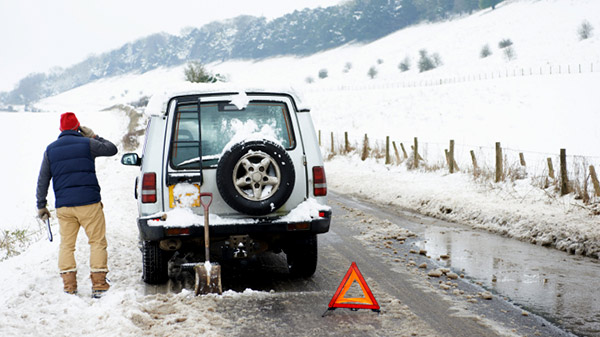Smartphones offer drivers a sense of security, with the promise that help is just a phone call away. But especially in extreme conditions, don’t count on your phone alone to keep you safe or to share your location in an emergency situation. Keep in mind that location services are not always accurate depending on network coverage in your location, the cell tower your phone connects to and other variables.
Take additional precautions before winter travel in case you become stranded in your car. Before setting out, tell your family or a friend which route you will be taking. If you become stranded, it’s better in most cases to stay with your car and let rescuers find you. Keep your phone plugged in and fully charged during your trip to better ensure it operates when needed. But if your smartphone location sharing lets you down, your preparations can keep you safe and comfortable while you wait for help.
SERVICE YOUR VEHICLE
Before heading out in the winter, the Federal Emergency Management Agency’s Ready.gov website outlines items a mechanic should check on your car:
- Antifreeze levels – ensure they are sufficient to avoid freezing.
- Battery and ignition system – should be in top condition and battery terminals should be clean.
- Brakes – check for wear and fluid levels.
- Exhaust system – check for leaks and crimped pipes and repair or replace as necessary. Carbon monoxide is deadly and usually gives no warning.
- Fuel and air filters – replace and keep water out of the system by using additives and maintaining a full tank of gas. A full tank will keep the fuel line from freezing.
- Heater and defroster – ensure they work properly.
- Lights and flashing hazard lights – check that all are functioning properly.
- Oil – check for level and weight. Heavier oils congeal more at low temperatures and do not lubricate as well.
- Thermostat – ensure it works properly.
- Windshield wiper equipment – repair any problems and maintain proper washer fluid level.
- Install good winter tires – make sure the tires have adequate tread. All-weather radials are usually adequate for most winter conditions. However, some jurisdictions require that to drive on their roads, vehicles must be equipped with chains or snow tires with studs.
EMERGENCY KIT
In addition, carry an emergency kit in your car:
- a shovel
- windshield scraper and small broom
- flashlight
- battery-powered radio and extra batteries
- water and snack food
- matches
- extra hats, socks and mittens
- first aid kit with pocket knife
- necessary medications
- blanket(s)
- tow chain or rope
- road salt and sand
- booster cables
- emergency flares
- fluorescent distress flag
IF YOU BECOME STRANDED
If you are broken down or stuck in your vehicle in a winter storm, stay put and wait for help. Consider these tips from the Montana Department of Transportation:
- Keep calm
- Indicate to others that you are in trouble if you are on a well-traveled road. Use the signaling devices in your survival kit, emergency lights on your vehicle or raise the hood and tie something bright to your antenna
- Remain in your vehicle unless you see a house or building within walking distance
- Run the engine to keep warm, but do it sparingly
- Check the exhaust pipe of your car to ensure snow has not blocked it. If this happens, you risk carbon monoxide poisoning
- Exercise, clap your hands, move your arms and legs vigorously or do other isometric exercises to keep your circulation going
- Take turns on watch if possible
- Stay awake if you are alone
- Ensure other drivers can see you if you are pulled over. Use hazard lights or auxiliary warning devices such as reflective triangles or flares; place the first one 10 feet from your car, the second 100 feet away and the third 200 feet away. On an undivided road, put one triangle 100 feet in front of your car, one 10 feet behind and another 100 feet behind.
The Illinois Emergency Management Agency’s Winter Weather Preparedness Guide has additional tips for motorists.
This loss control information is advisory only. The author assumes no responsibility for management or control of loss control activities. Not all exposures are identified in this article.

